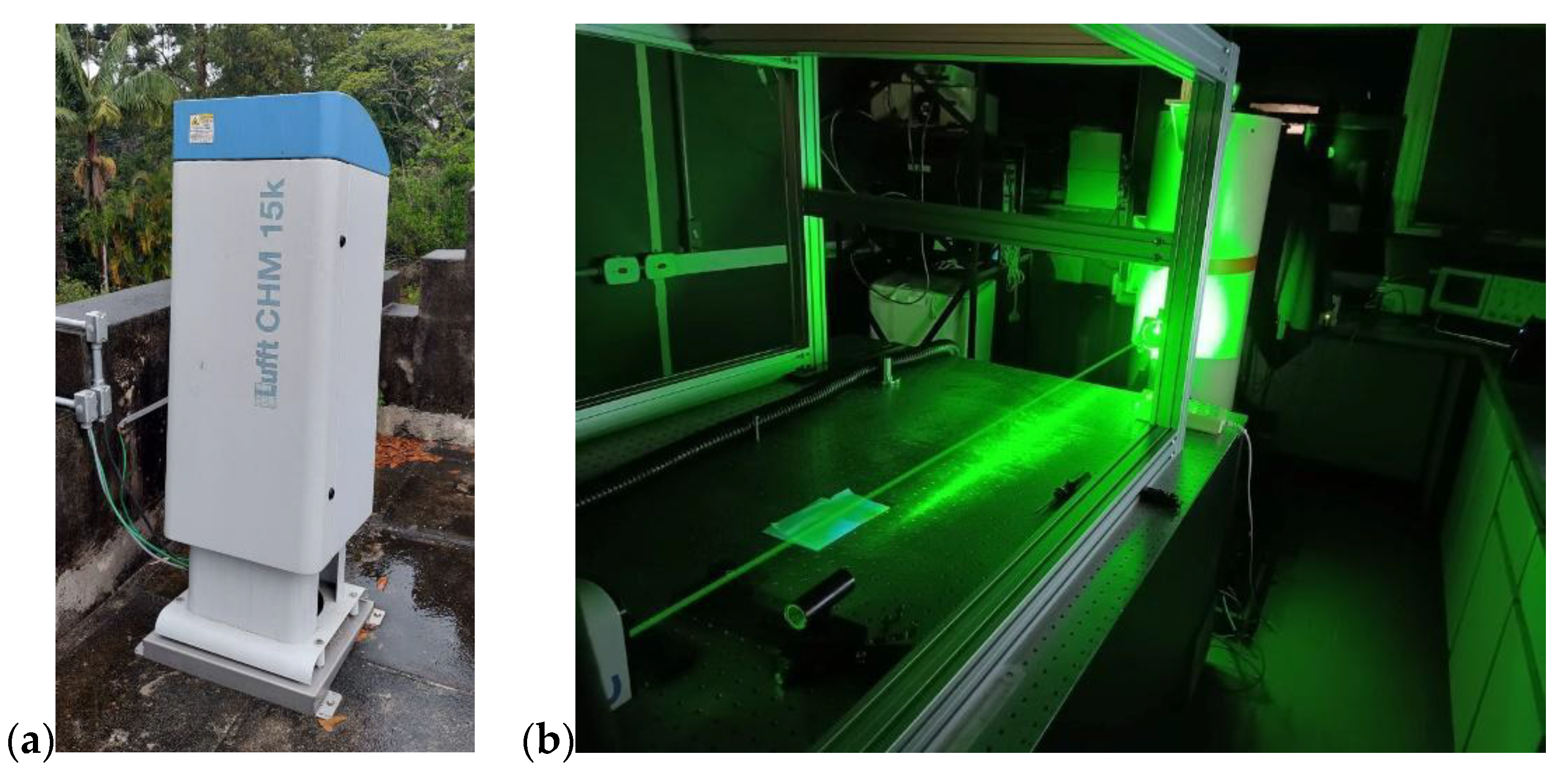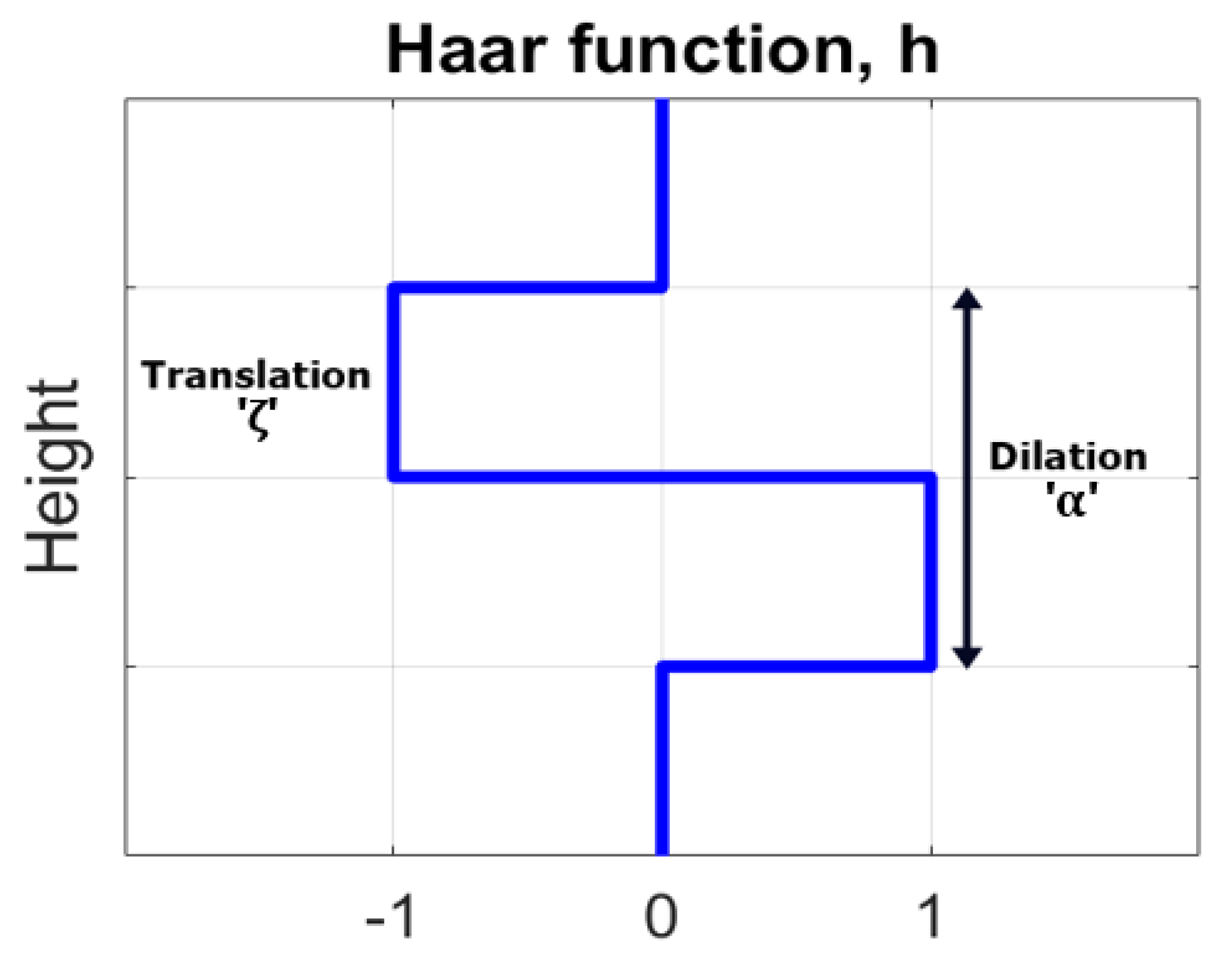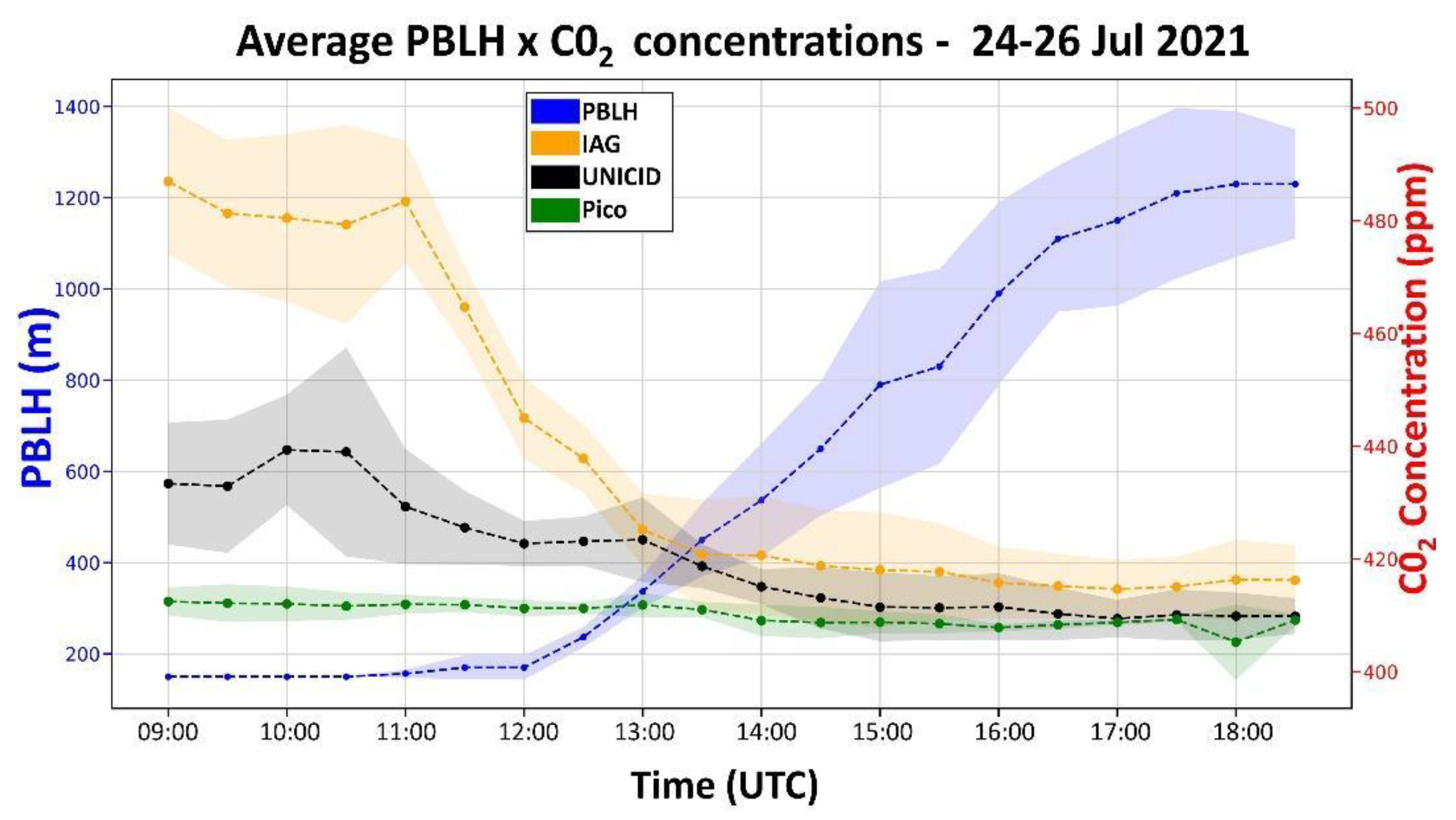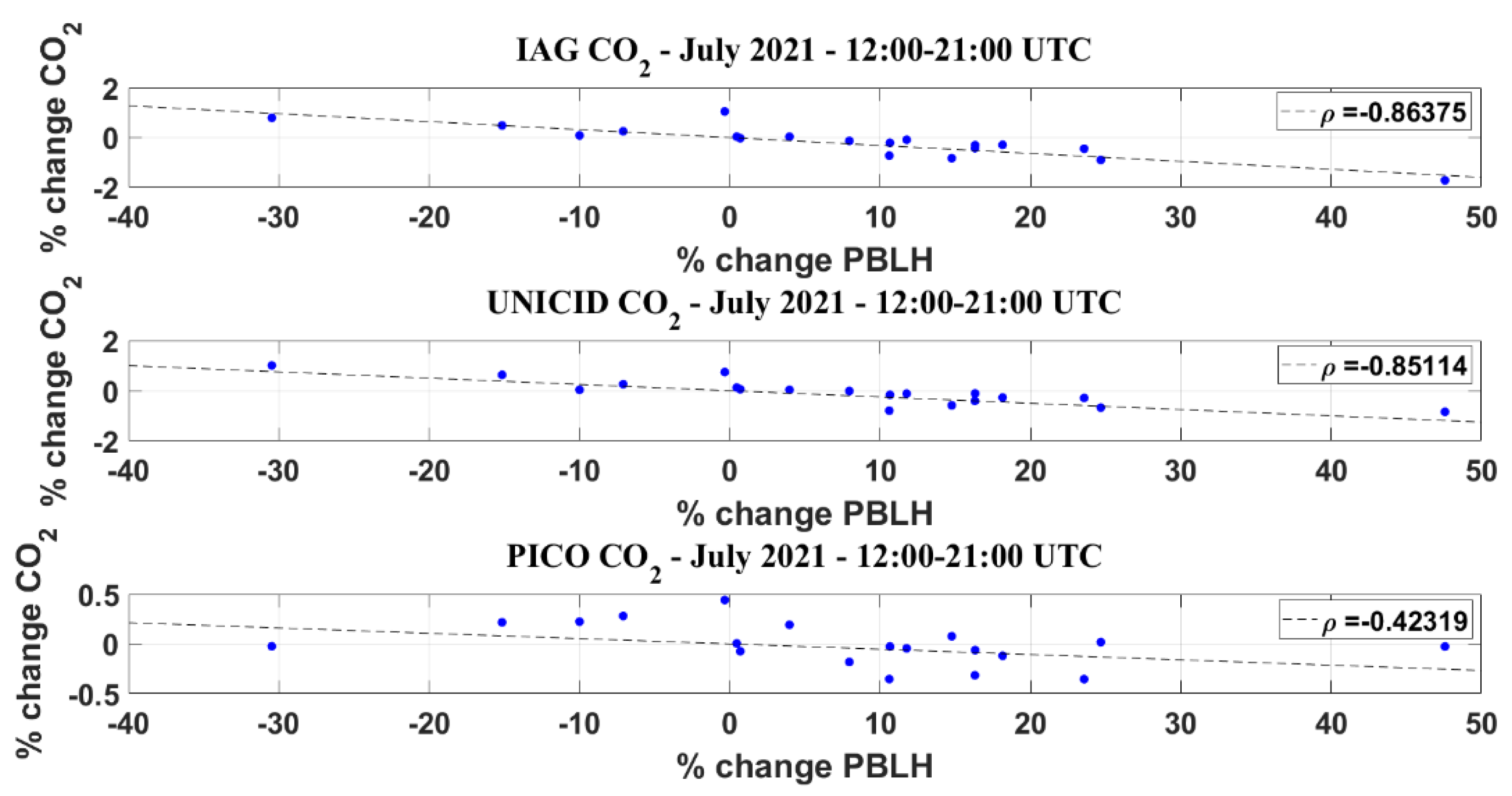Comparison of PBL Heights from Ceilometer Measurements and Greenhouse Gases Concentrations in São Paulo
Abstract
:1. Introduction
2. Materials and Methods
2.1. Data and Instrumentation
2.2. Locations
2.3. PBLH Retrieval Method
3. Results
3.1. PBLH Estimation
3.2. Case Study: CO2 and CH4 Concentrations in the Planetary Boundary Layer during 24–26 July 2021
3.2.1. CO2 and CH4 Concentration Variations across Measuring Stations
3.2.2. Day-to-Day Variations
3.3. Monthly Averages
4. Conclusions
Author Contributions
Funding
Institutional Review Board Statement
Informed Consent Statement
Data Availability Statement
Acknowledgments
Conflicts of Interest
References
- Stull, R.B. An Introduction to Boundary Layer Meteorology; Kluwer Academic Publishers: New York, NY, USA, 1988. [Google Scholar]
- Seibert, P.; Beyrich, F.; Gryning, S.-E.; Joffre, S.; Rasmussen, A.; Tercier, P. Review and intercomparison of operational methods for the determination of the mixing height. Atmos. Environ. 2000, 34, 1001–1027. [Google Scholar] [CrossRef]
- Medeiros, B.; Hall, A.; Stevens, B. What Controls the Mean Depth of the PBL? J. Clim. 2005, 18, 3157–3172. [Google Scholar] [CrossRef]
- Kim, J.; Verma, S.B. Carbon dioxide exchange in a temperate grassland ecosystem. Bound.-Layer Meteorol. 1990, 52, 135–149. [Google Scholar] [CrossRef]
- Jacobs, C.M.J.; De Bruin, H.A.R. The Sensitivity of Regional Transpiration to Land-Surface Characteristics: Significance of Feedback. J. Clim. 1992, 5, 683–698. [Google Scholar] [CrossRef]
- Moreira, G.d.A.; Guerrero-Rascado, J.L.; Bravo-Aranda, J.A.; Benavent-Oltra, J.A.; Ortiz-Amezcua, P.; Róman, R.; Bedoya-Velásquez, A.E.; Landulfo, E.; Alados-Arboledas, L. Study of the planetary boundary layer by microwave radiometer, elastic lidar and Doppler lidar estimations in Southern Iberian Peninsula. Atmos. Res. 2018, 213, 185–195. [Google Scholar] [CrossRef]
- Cohn, S.A.; Angevine, W.M. Boundary layer height and entrainment zone thickness measured by lidars and wind-profiling radars. J. Applied. Meteorol. 2000, 39, 1233–1247. [Google Scholar] [CrossRef]
- Cimini, D.; De Angelis, F.; Dupont, J.-C.; Pal, S.; Haeffelin, M. Mixing layer height retrievals by multichannel microwave radiometer observations. Atmos. Meas. Tech. 2013, 6, 2941–2951. [Google Scholar] [CrossRef]
- Menut, L.; Flamant, C.; Pelon, J.; Flamant, P.H. Urban boundary-layer height determination from lidar measurements over the Paris area. Appl. Opt. 1999, 38, 945–954. [Google Scholar] [CrossRef]
- Moreira, G.d.A.; Guerrero-Rascado, J.L.; Benavent-Oltra, J.A.; Ortiz-Amezcua, P.; Román, R.; Bedoya-Velásquez, A.E.; Bravo-Aranda, J.A.; Reyes, F.J.O.; Landulfo, E.; Alados-Arboledas, L. Analyzing the turbulent planetary boundary layer by remote sensing systems: The Doppler wind lidar, aerosol elastic lidar and microwave radiometer. Atmos. Meas. Tech. 2019, 19, 1263–1280. [Google Scholar] [CrossRef]
- Liu, B.; Ma, Y.; Gong, W.; Zhang, M.; Yang, J. Improved two-wavelength Lidar algorithm for retrieving atmospheric boundary layer height. J. Quant. Spectrosc. Radiat. Transf. 2018, 224, 55–61. [Google Scholar] [CrossRef]
- Davis, K.J.; Gamage, N.; Hagelberg, C.R.; Kiemle, C.; Lenschow, D.H.; Sullivan, P.P. An Objective Method for Deriving Atmospheric Structure from Airborne Lidar Observations. J. Atmos. Ocean. Technol. 2000, 17, 1455–1468. [Google Scholar] [CrossRef]
- Li, H.; Yang, Y.; Hu, X.; Huang, Z.; Wang, G.; Zhang, B.; Zhang, T. Evaluation of retrieval methods of daytime convective boundary layer height based on lidar data. J. Geophys. Res. Atmos. 2017, 122, 4578–4593. [Google Scholar] [CrossRef]
- Weitkamp, C. Lidar: Range-Resolved Optical Remote Sensing of the Atmosphere. In Springer Series in Optical Sciences; Springer: New York, NY, USA, 2005; Volume 102. [Google Scholar]
- Kovalev, V.A.; Eichinger, W.E. Elastic Lidar: Theory, Practice, and Analysis Methods; John Wiley & Sons: Hoboken, NJ, USA, 2004. [Google Scholar]
- Baars, H.; Ansmann, A.; Engelmann, R.; Althausen, D. Continuous monitoring of the boundary-layer top with lidar. Atmos. Meas. Tech. 2008, 8, 7281–7296. [Google Scholar] [CrossRef]
- Martucci, G.; Matthey, R.; Mitev, V.; Richner, H. Comparison between Backscatter Lidar and Radiosonde Measurements of the Diurnal and Nocturnal Stratification in the Lower Troposphere. J. Atmos. Ocean. Technol. 2007, 24, 1231–1244. [Google Scholar] [CrossRef]
- Granados-Muñoz, M.J.; Navas-Guzmán, F.; Bravo-Aranda, J.A.; Guerrero-Rascado, J.L.; Lyamani, H.; Fernández-Gálvez, J.; Alados-Arboledas, L. Automatic determination of the planetary boundary layer height using lidar: One-year analysis over southeastern Spain. J. Geophys. Res. Atmos. 2012, 117, D18208. [Google Scholar] [CrossRef]
- Moreira, G.d.A.; Lopes, F.J.d.S.; Guerrero-Rascado, J.L.; Granados-Muñoz, M.J.; Bourayou, R.; Landulfo, E. Comparison between two algorithms based on different wavelets to obtain the Planetary Boundary Layer height. In Proceedings of the SPIE 9246, Lidar Technologies, Techniques, and Measurements for Atmospheric Remote Sensing, 92460H, Ottawa, ON, USA, 18 November 2014; p. 92460D. [Google Scholar]
- Pal, S.; Behrendt, A.; Wulfmeyer, V. Elastic-backscatter-lidar-based characterization of the convective boundary layer and investigation of related statistics. Ann. Geophys. 2010, 28, 825–847. [Google Scholar] [CrossRef]
- Hooper, W.P.; Eloranta, E.W. Lidar measurements of wind in the planetary boundary layer: The method, accuracy, and results from joint measurements with radiosonde and kytoon. J. Appl. Meteorol. Climatol. 1986, 25, 990–1001. [Google Scholar] [CrossRef]
- Piironen, A.K.; Eloranta, E.W. Convective boundary layer mean depths and cloud geometrical properties obtained from volume imaging lidar data. J. Geophys. Res. Atmos. 1995, 100, 25569–25576. [Google Scholar] [CrossRef]
- Hayden, K.; Anlauf, K.; Hoff, R.; Strapp, J.; Bottenheim, J.; Wiebe, H.; Froude, F.; Martin, J.; Steyn, D.; McKendry, I. The vertical chemical and meteorological structure of the boundary layer in the Lower Fraser Valley during Pacific’93. Atmos. Environ. 1997, 31, 2089–2105. [Google Scholar] [CrossRef]
- De Bruine, M.; Apituley, A.; Donovan, D.P.; Baltink, H.K.; de Haij, M.J. Pathfinder: Applying graph theory to consistent tracking of daytime mixed layer height with backscatter lidar. Atmos. Meas. Tech. 2017, 10, 1893–1909. [Google Scholar] [CrossRef]
- Caicedo, V.; Rappenglück, B.; Lefer, B.; Morris, G.; Toledo, D.; Delgado, R. Comparison of aerosol lidar retrieval methods for boundary layer height detection using ceilometer aerosol backscatter data. Atmos. Meas. Tech. 2017, 10, 1609–1622. [Google Scholar] [CrossRef]
- Brooks, I.M. Finding Boundary Layer Top: Application of a Wavelet Covariance Transform to Lidar Backscatter Profiles. J. Atmos. Ocean. Technol. 2003, 20, 1092–1105. [Google Scholar] [CrossRef]
- Uzan, L.; Egert, S.; Alpert, P. Ceilometer evaluation of the eastern Mediterranean summer boundary layer height—First study of two Israeli sites. Atmos. Meas. Tech. 2016, 9, 4387–4398. [Google Scholar] [CrossRef]
- Steyn, D.G.; Baldi, M.; Hoff, R. The Detection of Mixed Layer Depth and Entrainment Zone Thickness from Lidar Backscatter Profiles. J. Atmos. Oceanic Technol. 1999, 16, 953–959. [Google Scholar] [CrossRef]
- Eresmaa, N.; Karppinen, A.; Joffre, S.M.; Räsänen, J.; Talvitie, H. Mixing height determination by ceilometer. Atmos. Meas. Tech. 2006, 6, 1485–1493. [Google Scholar] [CrossRef]
- Haeffelin, M.; Angelini, F.; Morille, Y.; Martucci, G.; Frey, S.; Gobbi, G.P.; Lolli, S.; O’dowd, C.D.; Sauvage, L.; Xueref-Rémy, I.; et al. Evaluation of Mixing-Height Retrievals from Automatic Profiling Lidars and Ceilometers in View of Future Integrated Networks in Europe. Boundary-Layer Meteorol. 2012, 143, 49–75. [Google Scholar] [CrossRef]
- Culf, A.; Fisch, G.; Malhi, Y.; Nobre, C. The influence of the atmospheric boundary layer on carbon dioxide concentrations over a tropical forest. Agric. For. Meteorol. 1997, 85, 149–158. [Google Scholar] [CrossRef]
- Carvalho, V.S.B.; Freitas, E.D.; Martins, L.D.; Martins, J.A.; Mazzoli, C.R.; Andrade, M.d.F. Air quality status and trends over the Metropolitan Area of São Paulo, Brazil as a result of emission control policies. Environ. Sci. Policy 2015, 47, 68–79. [Google Scholar] [CrossRef]
- Ballantyne, A.P.; Alden, C.B.; Miller, J.B.; Tans, P.P.; White, J.W.C. Increase in observed net carbon dioxide uptake by land and oceans during the past 50 years. Nature 2012, 488, 70–72. [Google Scholar] [CrossRef]
- Hodnebrog, O.; Aamaas, B.; Fuglestvedt, J.S.; Marston, G.; Myhre, G.; Nielsen, C.J.; Sandstad, M.; Shine, K.P.; Wallington, T.J. Updated Global Warming Potentials and Radiative Efficiencies of Halocarbons and Other Weak Atmospheric Absorbers. Rev. Geophys. 2020, 58, e2019RG000691. [Google Scholar] [CrossRef]
- IPCC; Masson-Delmotte, V.; Zhai, P.; Pirani, A.; Connors, S.L.; Péan, C.; Berger, S.; Caud, N.; Chen, Y.; Goldfarb, L.; et al. Climate Change 2021: The Physical Science Basis. In Contribution of Working Group I to the Sixth Assessment Report of the Intergovernmental Panel on Climate Change; Cambridge University Press: Cambridge, UK; New York, NY, USA, 2021; pp. 3–32. [Google Scholar]
- WMO. The State of Greenhouse Gases in the Atmosphere Based on Global Observations through 2020. In Greenhouse Gas Bulletin (GHG Bulletin); WMO: Geneva, Switzerland, 2021; Volume 17, p. 67. [Google Scholar]
- Ramanathan, V.; Cicerone, R.J.; Singh, H.B.; Kiehl, J.T. Trace gas trends and their potential role in climate change. J. Geophys. Res. 1985, 90, 5547–5566. [Google Scholar] [CrossRef]
- Myhre, G.; Samset, B.H.; Schulz, M.; Balkanski, Y.; Bauer, S.; Berntsen, T.K.; Bian, H.; Bellouin, N.; Chin, M.; Diehl, T.; et al. Radiative forcing of the direct aerosol effect from AeroCom Phase II simulations. Atmos. Meas. Tech. 2013, 13, 1853–1877. [Google Scholar] [CrossRef]
- Canadell, J.G.; Ciais, P.; Dhakal, S.; Dolman, H.; Friedlingstein, P.; Gurney, K.R.; Held, A.; Jackson, R.B.; Le Quéré, C.; Malone, E.L.; et al. Interactions of the carbon cycle, human activity, and the climate system: A research portfolio. Curr. Opin. Environ. Sustain. 2010, 2, 301–311. [Google Scholar] [CrossRef]
- IBGE—Instituto Brasileiro de Geografia e Estatística Home Page. Available online: http://ibge.gov.br (accessed on 24 February 2023).
- De Oliveira, A.P.; Filho, E.P.M.; Ferreira, M.J.; Codato, G.; Ribeiro, F.N.D.; Landulfo, E.; Moreira, G.d.A.; Pereira, M.M.R.; Mlakar, P.; Boznar, M.Z.; et al. Assessing Urban Effects on the Elimate of Metropolitan Regions Of Brazil—Preliminary Results of the MCITY BRAZIL Project. Explor. Environ. Sci. Res. 2020, 1, 38–77. [Google Scholar] [CrossRef]
- Tang, G.; Zhang, J.; Zhu, X.; Song, T.; Münkel, C.; Hu, B.; Schäfer, K.; Liu, Z.; Zhang, J.; Wang, L.; et al. Mixing layer height and its implications for air pollution over Beijing, China. Atmos. Meas. Tech. 2016, 16, 2459–2475. [Google Scholar] [CrossRef]
- Moreira, G.d.A.; de Oliveira, A.P.; Codato, G.; Sánchez, M.P.; Tito, J.V.; e Silva, L.A.H.; da Silveira, L.C.; da Silva, J.J.; Lopes, F.J.d.S.; Landulfo, E. Assessing Spatial Variation of PBL Height and Aerosol Layer Aloft in São Paulo Megacity Using Simul-taneously Two Lidar during Winter 2019. Atmosphere 2022, 13, 611. [Google Scholar] [CrossRef]
- Stein, A.F.; Draxler, R.R.; Rolph, G.D.; Stunder, B.J.B.; Cohen, M.D.; Ngan, F. NOAA’s HYSPLIT Atmospheric Transport and Dispersion Modeling System. Bull. Am. Meteorol. Soc. 2015, 96, 2059–2077. [Google Scholar] [CrossRef]
- Rolph, G.; Stein, A.; Stunder, B. Real-time Environmental Applications and Display sYstem: READY. Environ. Model. Softw. 2017, 95, 210–228. [Google Scholar] [CrossRef]
- Wang, P.; Zhou, W.; Niu, Z.; Xiong, X.; Wu, S.; Cheng, P.; Hou, Y.; Lu, X.; Du, H. Spatio-temporal variability of atmospheric CO2 and its main causes: A case study in Xi’an city, China. Atmos. Res. 2021, 249, 105346. [Google Scholar] [CrossRef]
- Metya, A.; Datye, A.; Chakraborty, S.; Tiwari, Y.K.; Sarma, D.; Bora, A.; Gogoi, N. Diurnal and seasonal variability of CO2 and CH4 concentration in a semi-urban environment of western India. Sci. Rep. 2021, 11, 1–13. [Google Scholar] [CrossRef]
- Vaghjiani, G.L.; Ravishankara, A. New measurement of the rate coefficient for the reaction of OH with methane. Nature 1991, 350, 406–409. [Google Scholar] [CrossRef]
- Oliveira, A.P.; Bornstein, R.D.; Soares, J. Annual and Diurnal Wind Patterns in the City of São Paulo. Water Air Soil Pollut. 2003, 3, 3–15. [Google Scholar] [CrossRef]
- Lolli, S. Machine Learning Techniques for Vertical Lidar-Based Detection, Characterization, and Classification of Aerosols and Clouds: A Comprehensive Survey. Remote. Sens. 2023, 15, 4318. [Google Scholar] [CrossRef]

















| Site Name | Inlet Height (m agl) | Site Elevation (m asl) | Latitude | Longitude | Analyzer | Measuring |
|---|---|---|---|---|---|---|
| IAG | 15 | 731 | −23.55947 | −46.733533 | G2301 II | CO2, CH4 |
| UNICID | 38 | 741 | −23.53586 | −46.559550 | G2401 | CO, CO2, CH4 |
| Pico do Jaraguá | 3 | 1079 | −23.45631 | −46.766094 | G2301-m | CO2, CH4 |
Disclaimer/Publisher’s Note: The statements, opinions and data contained in all publications are solely those of the individual author(s) and contributor(s) and not of MDPI and/or the editor(s). MDPI and/or the editor(s) disclaim responsibility for any injury to people or property resulting from any ideas, methods, instructions or products referred to in the content. |
© 2023 by the authors. Licensee MDPI, Basel, Switzerland. This article is an open access article distributed under the terms and conditions of the Creative Commons Attribution (CC BY) license (https://creativecommons.org/licenses/by/4.0/).
Share and Cite
Vieira dos Santos, A.; Cristina Araújo, E.; da Silva Andrade, I.; Corrêa, T.; Talita Amorim Marques, M.; Eduardo Souto-Oliveira, C.; Franchi Leonardo, N.; de Mendonça Macedo, F.; Souza, G.; Pereira de Queiroz Lopes, P.; et al. Comparison of PBL Heights from Ceilometer Measurements and Greenhouse Gases Concentrations in São Paulo. Atmosphere 2023, 14, 1830. https://doi.org/10.3390/atmos14121830
Vieira dos Santos A, Cristina Araújo E, da Silva Andrade I, Corrêa T, Talita Amorim Marques M, Eduardo Souto-Oliveira C, Franchi Leonardo N, de Mendonça Macedo F, Souza G, Pereira de Queiroz Lopes P, et al. Comparison of PBL Heights from Ceilometer Measurements and Greenhouse Gases Concentrations in São Paulo. Atmosphere. 2023; 14(12):1830. https://doi.org/10.3390/atmos14121830
Chicago/Turabian StyleVieira dos Santos, Amanda, Elaine Cristina Araújo, Izabel da Silva Andrade, Thais Corrêa, Márcia Talita Amorim Marques, Carlos Eduardo Souto-Oliveira, Noele Franchi Leonardo, Fernanda de Mendonça Macedo, Giovanni Souza, Pérola Pereira de Queiroz Lopes, and et al. 2023. "Comparison of PBL Heights from Ceilometer Measurements and Greenhouse Gases Concentrations in São Paulo" Atmosphere 14, no. 12: 1830. https://doi.org/10.3390/atmos14121830
APA StyleVieira dos Santos, A., Cristina Araújo, E., da Silva Andrade, I., Corrêa, T., Talita Amorim Marques, M., Eduardo Souto-Oliveira, C., Franchi Leonardo, N., de Mendonça Macedo, F., Souza, G., Pereira de Queiroz Lopes, P., de Arruda Moreira, G., de Fátima Andrade, M., & Landulfo, E. (2023). Comparison of PBL Heights from Ceilometer Measurements and Greenhouse Gases Concentrations in São Paulo. Atmosphere, 14(12), 1830. https://doi.org/10.3390/atmos14121830







